Do you know Negeri van Oranje (2015), an Indonesian movie? One of my reasons why I wanted to see this movie was because I always wonder how Indonesian people living abroad. Just information, I really want to live in another countries or at least have some overseas trips. As you know, Negeri van Oranje refers to Netherland. But from that movie, I put my interest more to Prague rather than the Netherland. Moreover, in 2016 Indonesia has Surat dari Praha (Letters from Prague). And I really want to take a trip to Prague soon (I don't know what my "soon" means, someday amen). First, let me tell you some essential informations of Prague.
 |
| Prague en.wikipedia.org |
Prague is the capital and largest city of the Czech Republic. It is the 14th largest city in the European Union. It is also the historical capital of Bohemia. Situated in the north-west of the country on the Vltava River, the city is home to about 1.26 million people, while its larger urban zone is estimated to have a population of nearly 2 million. The city has a temperate climate, with warm summers and chilly winters. Prague has the lowest unemployment rate in the European Union.
Prague doesn’t need a brochure to sell itself. Thirty years ago, Prague (or Praha as the Czech pronounce it) was a mystery to world travelers; now, however, it is becoming one of the most popular destinations in Europe, drawing about 4 million visitors each year – and for good reason.
Prague really has something for everyone. It's beauty rivals even Paris, its history spans a millennium. It is one of the continent's premier destinations, combining glorious architecture, lively beer gardens, medieval lanes, riverside parks, interesting museums, a thrilling history and a cosmopolitan vibe that sweeps you off your feet. No matter how long you stay, you will always wish it was longer.
Czech Language
Czech is the national language, and its main greeting is Dobrý den.
This is the first thing to say to anyone we don't know very well - i.e. entering a store, greeting a cashier, waiter, etc.
Besides, many people in Prague speak English. And, many older Czechs speak German. Slovak is also spoken but in small numbers.
| Main phrases in Czech utexas.edu |
Weather
The weather in Prague is totally unpredictable but Prague has four very real, distinct seasons.
- Spring brings flowers and mild temps.
 |
| Blooming Tulips myczechrepublic.com |
- Summer is warm and green.
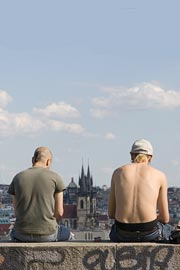 |
| Hanging out because it's warm! myczechrepublic.com |
- Autumn can be crisp, cool and sometimes cloudy.
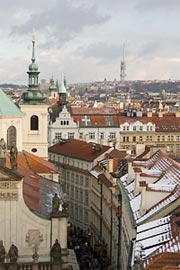 |
| Sky in Czech when Autumn myczechrepublic.com |
- Winter can be quite cold with occasional snow.
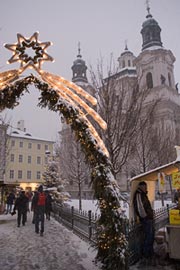 |
| Old Town Square with Snow myczechrepublic.com |
Czech Currency
This is a big point of confusion for a lot of people. The short answer is, they don't use euros. They use Czech koruna (crowns). You might find a few places to accept euros, but don't try to figure who takes euros and who doesn't. It's just a waste of time.
As of now one Czech Krona is equal to five Pakistani Rupees, which means you can get far more bang for your rupee than any other international destination around the world (save perhaps India. But the Czech visa is, obviously, relatively much easier to obtain).
Czech Food
First off, typical food in Prague is not diet food. So, if you're visiting Prague and traditional Czech restaurants, then consider leaving your diet at home.
Traditional meals in standard Czech restaurants can be a bit heavy for some visitors. Chefs won't be watching your diet or skimping on salt when they cook.
Of course, Prague has many international flavors to offer. But, Czech food is typically of the "meat and potatoes" variety.
- Meat... it's a key ingredient to nearly all meals. Pork, beef, chicken and fiish are all very popular in local restaurants.
- Vegetables... they might even consider heavy potato dumplings to be a vegetable. Green vegetables aren't very common and side salads may include a simple mixture of grated cabbage and carrot.
- Bread... it's a key element of Czech food. Rye bread in particular is very good in Czech Republic and you'll find a variety of tasty baked goods as well.
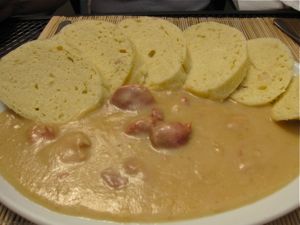 |
| Vepřo - knedlo - zelo my-prague-sights.com |
And the National Dish is... Vepřo - knedlo - zelo!
Yes, the Czech Republic has a national dish. It's one of those meals that locals will speak of with pride... "Have you tried vepřo, knedlo, zelo?" So when you visit Prague or wherever in the country, be sure to give it a try!
Vepřo, knedlo, zelo means Roast Pork - Dumplings - Sauerkraut. The roasted pork should be tender with a sauce dripped over it and the sauerkraut. The dumplings are of the yeast variety.
Do I really make a plan to Prague?
Any guides to Prague in internet tell me, a plan is never a bad thing. You might scoff at this idea, but there's really so much to see in Prague.
"We just didn't have enough time to see everything."
-Dean and Martina, Czech+American root travelers.
Accomodation
There's no shortage of Prague accommodation. In recent years, Prague has burst with new hotels, pensions, apartment rentals, hostels and more. Rates are also very competitive. From 40 euros a night for hostels to 150 euros a night for luxury hotels.
Walk Everywhere
Prague's city center is very compact, so plan to walk most everywhere if you can. That means finding accommodation that is central. Ideally we will be able to walk from hotel or apartment to all or some of the key historical monuments.
Once we reach one attraction, the next will seemingly be just down the street. So, imagine walking from one to the next across the city center. So, it definitely pays to research a variety of central hotels before the arrival. And, of course, bring the walking shoes!
Sights and Attractions
 |
| National Museum, a dazzling introduction to Czech history visitcapitalcity.com |
Start your visit at the National Museum to get a dazzling introduction to Czech history. Built in the 1880s, the museum looms above Wenceslas square and is an architectural icon of the Czech National Revival. While the main displays of fossils, rocks and stuffed wildlife feel a bit old fashioned, the smaller galleries are an extravaganza of treasures. Bronze busts and statues pay tribute to Czech artists and heroes, medallions and jewels tell the stories of emperors and kings, and the bullet hole still riddling the facade are a reminder of the 1968 Warsaw Pact troops.
.jpg/640px-Old_Jewish_Cemetery,_Prague,_Czech_Republic_(73115203).jpg) |
| Cementiri Jueu commons.wikimedia.org |
Just a short walk away is the Jewish Cemetery, which opened in 1890 and now holds the remains of writer Franz Kafka. Each year, fans flock to the site on June 3rd, the anniversary of Kafka's death.
 |
| Charles Bridge, a favorite activity of both locals and tourists in Prague ethariesta.wordpress.com |
Spend the afternoon strolling along the Charles Bridge, a favorite activity of both locals and tourists in Prague. Commissioned by Charles IV in 1357, the bridge is loaded with visitors from morning until night. When you reach the end of the bridge at Stare Mesto, look down at the right side retaining wall to spy the Bearded Man. The carved stone head was used as a marker for the water levels during medieval times.
 |
| Prague Wallenstein Palace willgoto.com |
The nearby Wallenstein Palace houses the Senate of the Czech Republic but is open to visitors on the weekends. Built in 1630, the palace contains detailed ceiling frescoes that tell the story of Albrecht Wallenstein, who lead the Habsburg armies. The huge walled garden behind the palace is a peaceful oasis among the bustling streets, and changing exhibitions of modern art decorate the garden's east end.
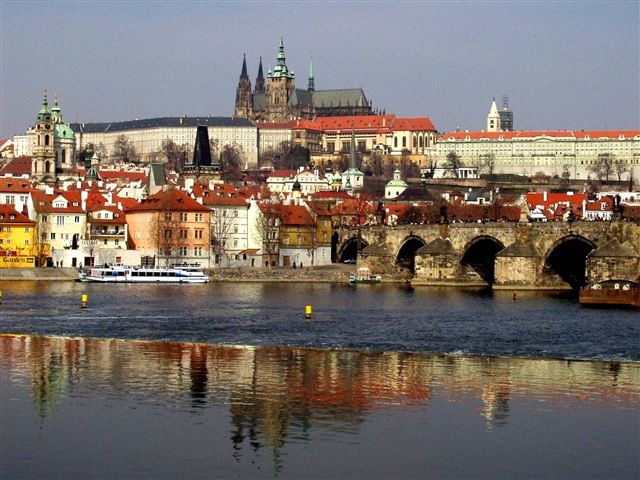 |
| Prague Castle is the world's largest ancient castle, covering an area larger than seven football fields eurobuildings.info |
The most popular attraction in Prague is its castle, and for good reason. It is the world's largest ancient castle, covering an area larger than seven football fields. Since its creation in the 9th century, the castle has been a fortified settlement and the seat of many Czech rulers. Today, visitors can explore two courtyards, the old royal palace section and an exhibition detailing the castle’s fascinating history.
 |
| Astronomical Clock beachrove.com |
Over 600 years old, Asstronomical Clock in Prague is one of the oldest (still functioning) astronomical clocks in the world. The photograph with the clock is a must-do to complete your visit to Prague – so get it out of the way first.
 |
| John Lennon Wall, where a picture of the Beatle was painted after his murder in 1980 visitcapitalcity.com |
Travelers from around the world will appreciate the John Lennon Wall, where a picture of the Beatle was painted after his murder in 1980. Lennon was a hero of pacifism to many young Czechs, and no matter how many times the secret police tried to wash away the artwork, portraits of Lennon kept popping up. The wall became a political focus for young Prague citizens and today is covered with peace messages and other graffiti.
 |
| Traditional Czech pubs survive next to Western-style cocktail bars, and Czech beer is on tap practically everywhere czechtourism.com |
In the past, most bars shut down by 10 pm and the city's nightlife was nearly non-existent, but today, visitors and locals have more than enough entertainment options to choose from. Traditional Czech pubs survive next to Western-style cocktail bars, and Czech beer is on tap practically everywhere. During the summer, locals love to unwind in the parks' beer gardens, and many bars offer incredible rooftop views of the city. Beyond the bars, visitors can cruise down the Vltava on evening tours, gamble at high-class casinos, dance to international DJs or take in some of the continent's finest theater and musical performances.
Public Transportations
Learning to travel in Prague is said to be easy. Prague's whole metro system in fact is straightforward, reliable and fairly accessible to everyone.
If you don't want to walk, use the metro or trams. The underground metro is better for longer distances while the trams are more flexible and cover the city in more detail.
For example you might want to take the #22 tram to Prague Castle instead of walking up the hill. Tickets are time sensitive so punch them when you get on the tram or before going into the metro.
Music
Music is everywhere in Prague, and a startling amount of it is good. Charles Bridge, Old Town Square, the entire city is just full of musicians – and such talented ones
Bars employ singers with guitars, cruise boats have live musicians, Churches have lovely choirs playing through out the day and even walking around the streets of Prague there are musical surprises with repertoires ranging from traditional folk music from all over Europe to unconventional original compositions. Best part – if you love their work, you can buy the CD for as little as KR 50 (50 crowns)
There are so many things from Prague that I can't explain here. But, a real thing is I really want to visit Prague, enjoy the night life, take some photos in front of John Lennon Wall, and dance along the Prague street musicians.
--------------------
https://en.wikipedia.org/
http://www.my-prague-sights.com/
http://www.visitcapitalcity.com/
http://www.thefridaytimes.com/
http://amiyumico.blogspot.co.id/
This article is made for my Tourism's task